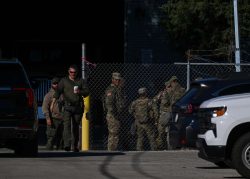
U.S. army vehicles including tanks are brought ashore in the Netherlands as a military unit is transported to Poland and Lithuania as part of a NATO mission to reinforce the alliance’s eastern flank after the Russian invasion of Ukraine, in Vlissingen, Netherlands January 11, 2023.
11:31 JST, January 19, 2023
The Biden administration is preparing to announce a roughly $2.5 billion military aid package for Ukraine that is expected to include dozens of Bradley and Stryker armored vehicles, according to two people familiar with the decision, as the Pentagon intensifies its support ahead of an expected counteroffensive against entrenched Russian forces.
The war has entered a phase, U.S. officials have said, that will require Ukrainian units to attack enemy forces in a concerted way, using tanks, armored vehicles, artillery and aviation in what is known as combined arms warfare. Bradleys and Strykers would significantly bolster their firepower and allow soldiers to move quickly around the battlefield.
The coming transfer could contain nearly 100 Strykers, one of these people said. It would mark the first time the Pentagon has supplied Ukraine with such vehicles. Those familiar with the plan spoke on the condition of anonymity to discuss it ahead of a formal announcement.
The Bradley fighting vehicles included in this transfer will be in addition to those announced earlier this month in a separate $3 billion arms package, the people said. The next tranche of aid also will include a substantial restock of ammunition for howitzers and rocket artillery, they said, and more mine-resistant vehicles.
The new vehicles are intended to complement the large-scale, combined arms training that several hundred Ukrainian soldiers are receiving at a U.S. military facility in Germany to help them change the dynamics of the battlefield, U.S. officials have said. As winter has taken hold, the fighting has concentrated in the south and east, degrading into a violent slugfest where both sides are suffering steep losses for modest gains.
“The Russians are really digging in. . . . They’re digging trenches, they’re putting in these dragon’s teeth, laying mines. They’re really trying to fortify that FLOT, that forward line of troops,” Undersecretary of Defense for Policy Colin Kahl told reporters at the Pentagon on Wednesday. “To enable the Ukrainians to break through given Russian defenses, the emphasis has been shifted to enabling them to combine fire and maneuver in a way that will prove to be more effective.”
It is unlikely, however, that this aid package will include one of Kyiv’s most impassioned requests: M1 Abrams main battle tanks. The administration has rejected those requests, pointing to the logistical and technical burdens of operating the systems and suggesting they could quickly become a hindrance for the Ukrainians.
“The Abrams tank is a very complicated piece of equipment. It’s expensive. It’s hard to train on. It has a jet engine. I think it’s about three gallons to the mile of jet fuel. It is not the easiest system to maintain,” Kahl said. “It may or may not be the right system, but we’ll continue to look at what makes make sense.”
Politico first reported last week that the transfer of U.S. Strykers was under consideration.
Bradleys and Strykers offer different capabilities. Strykers are eight-wheeled armored transports that top out at 60 miles per hour. They have multiple variants, including the most common, an infantry vehicle that can carry a squad of nine soldiers along with a driver and vehicle commander.
The vehicle’s rear door drops like a ramp, allowing soldiers to pour out into an active battle or walk to a fight from a distant infiltration point. Strykers have main armaments like heavy machine guns and automatic grenade launchers, with hatches that allow soldiers to stand up inside the vehicle and look outward to defend its flanks.
The vehicle was first used in combat in Iraq and Afghanistan, generating mixed reviews from U.S. soldiers. While quieter than an Abrams, it is less armored and more susceptible to getting stuck in the mud. The U.S. Army scrambled to add cages around the vehicles to help pre-detonate rocket-propelled grenades fired by insurgents. The cages added to the vehicle’s weight and dimensions, accelerating the wear and tear they endured.
It is unclear if the Strykers being sent to Ukraine will include such cages, which also make them harder to transport.
Bradleys, by contrast, are heavier and slower. They run on tracks that help them power through muddy conditions. These vehicles carry fewer troops than Strykers can, though their thicker armor and armaments, including TOW missiles and a 25mm cannon, make them more suitable for direct combat.
"News Services" POPULAR ARTICLE
-

American Playwright Jeremy O. Harris Arrested in Japan on Alleged Drug Smuggling
-

Japan’s Nikkei Stock Average as JGB Yields, Yen Rise on Rate-Hike Bets
-

Japan’s Nikkei Stock Average Licks Wounds after Selloff Sparked by BOJ Hike Bets (UPDATE 1)
-

Japan’s Nikkei Stock Average Buoyed by Stable Yen; SoftBank’s Slide Caps Gains (UPDATE 1)
-

Japanese Bond Yields Zoom, Stocks Slide as Rate Hike Looms
JN ACCESS RANKING
-

Tokyo Economic Security Forum to Hold Inaugural Meeting Amid Tense Global Environment
-

Keidanren Chairman Yoshinobu Tsutsui Visits Kashiwazaki-Kariwa Nuclear Power Plant; Inspects New Emergency Safety System
-

Imports of Rare Earths from China Facing Delays, May Be Caused by Deterioration of Japan-China Relations
-

University of Tokyo Professor Discusses Japanese Economic Security in Interview Ahead of Forum
-

Japan Pulls out of Vietnam Nuclear Project, Complicating Hanoi’s Power Plans
























